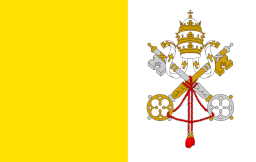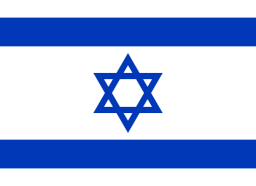| 1 Il Signore disse ancora a Mosè e ad Aronne: | 1 Yahweh said to Moses and Aaron, |
| 2 "Un uomo sulla cui pelle si formi un gonfiore o un eczema o una macchia e si preveda un caso di lebbra, sia portato da Aronne sacerdote o da uno dei suoi figli sacerdoti; | 2 'If a swel ing or scab or spot appears on someone's skin, which could develop into a contagious skin-disease, that person must then be taken to the priest, either Aaron or one of his sons. |
| 3 il sacerdote esamini la piaga sulla sua pelle: se sulla piaga il pelo è diventato bianco e la piaga appare incavata nella pelle, è un caso di lebbra. Veduto ciò, il sacerdote lo dichiari impuro. | 3 The priest wil examine the disease on the skin. If the hair on the diseased part has turned white, or ifthe disease bites into the skin, the skin-disease is contagious, and after examination the priest wil declare theperson unclean. |
| 4 Se la macchia sulla pelle è bianca, ma non appare incavata nella pelle e il pelo su di essa non è diventato bianco, il sacerdote isolerà l'uomo colpito dalla piaga per sette giorni. | 4 But if there is a white spot on the skin without any visible depression of the skin or whitening of thehair, the priest wil isolate the sick person for seven days. |
| 5 Il sacerdote lo esamini il settimo giorno: se la piaga gli appare stazionaria e non si è diffusa sulla pelle, il sacerdote isoli l'uomo colpito dalla piaga per altri sette giorni. | 5 On the seventh day he wil examine the person, and if he observes that the disease persists thoughwithout spreading over the skin, he will isolate the person for a further seven days |
| 6 Il settimo giorno lo riesamini; se la piaga è diminuita, non si è diffusa sulla pelle, il sacerdote dichiarerà tale uomo puro: è un eczema. Egli lavi le sue vesti ed è puro. | 6 and examine him again on the seventh. If he finds that the disease has faded and has not spread overthe skin, the priest wil declare the person clean. This was merely a scab. Once he has washed his clothing hewil be clean. |
| 7 Se l'eczema si è diffuso sulla pelle dopo che il malato è stato esaminato dal sacerdote e dichiarato puro, si presenti di nuovo al sacerdote. | 7 'But if the scab spreads over the skin after the sick person has been examined by the priest anddeclared clean, then he wil let himself be examined again by the priest. |
| 8 Il sacerdote lo esamini; se l'eczema si è diffuso sulla pelle, il sacerdote lo dichiari impuro; è lebbra. | 8 After examining him and certifying the spread of the scab over the skin, the priest wil declare himunclean: it is a contagious skin-disease. |
| 9 Quando appaia su un uomo una macchia di lebbra, sia portato dal sacerdote. | 9 'Someone who has a contagious skin-disease must be taken to the priest. |
| 10 Il sacerdote lo esamini; se c'è un gonfiore biancastro sulla pelle e il pelo è diventato bianco e c'è una zona di carne viva sul gonfiore: | 10 The priest wil examine the sick person, and if he finds a whitish swel ing with whitening of the hairand an ulcer forming on the skin, |
| 11 è lebbra inveterata sulla pelle; il sacerdote lo dichiari impuro. Lo isoli, perché è impuro. | 11 this is a dormant skin-disease, and the priest wil declare the person unclean. He wil not isolate him;he is obviously unclean. |
| 12 Se la lebbra si diffonde sulla pelle e copre tutta la pelle dell'uomo, dalla testa ai piedi, dovunque il sacerdote osservi, | 12 'But if the disease spreads all through the skin, if it covers the person entirely from head to foot so faras the priest can see, |
| 13 questi esamini il paziente; se la lebbra ha coperto tutta la sua carne, allora dichiari puro l'uomo colpito dalla piaga; è diventato tutto bianco; è puro. | 13 the priest wil then examine the sick person and, if he finds that the skin-disease covers his wholebody, declare the sick person clean. Since it has al become white, he is clean. |
| 14 Nel giorno in cui ricomparisse in lui un'ulcera è impuro; | 14 But as soon as an ulcer appears on him, he wil be unclean. |
| 15 il sacerdote esamini l'ulcera e lo dichiari impuro; l'ulcera è cosa impura, è lebbra. | 15 After examining the ulcer, the priest will declare him unclean: the ulcer is unclean, it is contagious. |
| 16 Se invece l'ulcera si restringe e diventa bianca, vada dal sacerdote; | 16 But if the ulcer becomes white again, the sick person wil go to the priest; |
| 17 il sacerdote lo esamini; se la piaga è diventata bianca, il sacerdote dichiari puro l'uomo colpito dalla piaga; è puro. | 17 the priest wil examine him and if he finds that the disease has turned white, he wil declare the sickperson clean: he is clean. |
| 18 Quando si è prodotto sulla pelle di qualcuno un ascesso ed è guarito, | 18 'When an ulcer appears on someone's skin, and then gets better, |
| 19 e al posto dell'ascesso c'è un gonfiore biancastro o una macchia bianco-rossastra, il malato sia esaminato dal sacerdote. | 19 and if then a white swel ing or a reddish-white spot forms on the same place, the sick person wilshow himself to the priest. |
| 20 Il sacerdote lo esamini; se c'è un incavo visibile sulla pelle e il pelo è diventato bianco, il sacerdote lo dichiari impuro: è una piaga di lebbra che si diffonde sull'ascesso. | 20 The priest wil examine him, and if he finds a visible depression in the skin and a whitening of thehair, he wil declare the person unclean: this is a case of contagious skin-disease breaking out in an ulcer. |
| 21 Se il sacerdote esamina l'ascesso, e non vede in esso il pelo bianco, se non è più incavato nella pelle e si è attenuato, il sacerdote isoli il malato per sette giorni. | 21 But if on examination the priest finds neither white hair nor depression of the skin, but a fading of theaffected part, he wil isolate the sick person for seven days. |
| 22 Se il male si diffonde chiaramente sulla pelle, il sacerdote dichiari il malato impuro: è lebbra. | 22 If the disease has then spread over the skin, he will declare the person unclean: this is a case ofcontagious skin-disease. |
| 23 Se la macchia è rimasta stazionaria senza diffondersi, è la cicatrice di un ascesso, il sacerdote lo dichiari puro. | 23 But if the spot has stayed where it was and has not spread, it is the scar of the ulcer and the priestwil declare the person clean. |
| 24 Se sulla pelle di qualcuno c'è un'ustione e la piaga dell'ustione è una macchia bianco-rossastra o biancastra, | 24 'If someone has a burn on the skin and an abscess, a reddish-white or white spot, forms on the burn, |
| 25 il sacerdote la esamini; se il pelo è diventato bianco sulla macchia ed essa appare incavata nella pelle, è lebbra che si diffonde nella bruciatura. Il sacerdote dichiari il malato impuro: è un caso di lebbra. | 25 the priest wil then examine it. If he finds a whitening of the hair or a visible depression of the mark onthe skin, a contagious disease has broken out in the burn. The priest wil declare the sick person unclean: this isa contagious skin-disease. |
| 26 Se il sacerdote lo esamina, e sulla macchia il pelo non è bianco e non c'è incavo nella pelle e la macchia si attenua, il sacerdote isoli il malato per sette giorni. | 26 If on the other hand the priest on examination does not find white hair on the mark or depression ofthe skin, but a fading of the mark, the priest will isolate the person for seven days. |
| 27 Il sacerdote lo esamini il settimo giorno: se la macchia si è diffusa sulla pelle, il sacerdote dichiari il malato impuro: è un caso di lebbra; | 27 He wil examine the person on the seventh day and, if the disease has spread over the skin, he wildeclare the sick person unclean: this is a case of contagious skin-disease. |
| 28 se la macchia resta stazionaria senza diffondersi sulla pelle e si attenua, è un gonfiore dovuto alla bruciatura; il sacerdote dichiari quell'uomo puro, perché è la cicatrice della bruciatura. | 28 If the mark has stayed where it was and has not spread over the skin, but has faded instead, it wasonly a swel ing due to the burn. The priest wil declare the person clean: it is merely a burn scar. |
| 29 Se un uomo o una donna hanno una piaga sulla testa o sul mento, | 29 'If a man or a woman has a sore on the head or chin, |
| 30 il sacerdote esamini la piaga; se appare incavata nella pelle e in essa il pelo è giallastro e fine, il sacerdote lo dichiari impuro: è tigna, cioè la lebbra della testa e del mento. | 30 the priest wil examine the sore; and if he finds a depression visible in the skin, with the hair on ityel ow and thin, he wil declare the sick person unclean: this is tinea, that is to say, a contagious skin-disease of the head or chin. |
| 31 Quando il sacerdote esamina la piaga della tigna, e non appare incavata nella pelle e il pelo in essa non è giallastro, il sacerdote isoli per sette giorni la persona colpita da piaga di tigna. | 31 If on examining this case of tinea the priest finds no visible depression in the skin and no yellow hair,he wil isolate the person so affected for seven days. |
| 32 Il sacerdote esamini la piaga il settimo giorno; se la tigna non si è diffusa e non c'è in essa pelo giallastro e la parte colpita dalla tigna non appare incavata nella pelle, | 32 He wil examine the infected part on the seventh day, and if he finds that the tinea has not spread,that the hair on it is not yel ow, and that there is no visible depression in the skin, |
| 33 il malato si raserà, ma non raserà la parte colpita dalla tigna: il sacerdote isolerà il tignoso ancora per sette giorni. | 33 the sick person will shave his hair off, all except the part affected with tinea, and the priest wil againisolate him for seven days. |
| 34 Il sacerdote esamini la tigna il settimo giorno; se la tigna non si è diffusa sulla pelle e la parte colpita non appare incavata nella pelle, il sacerdote lo dichiari puro; il malato lavi le sue vesti ed è puro. | 34 He wil examine the infected part on the seventh day, and if he finds that it has not spread over theskin, and that there is no visible depression of the skin, the priest wil declare the sick person clean. Afterwashing his clothes the person wil be clean. |
| 35 Se la tigna si è diffusa sulla pelle dopo che il malato è stato dichiarato puro, | 35 But if after this purification the tinea does spread over the skin, |
| 36 il sacerdote lo esamini; se la tigna si è diffusa sulla pelle, il malato è impuro; il sacerdote non stia a osservare se il pelo è giallastro. | 36 the priest wil examine the person; if he finds that the tinea has indeed spread over the skin, the sickperson is unclean, and there is no need to verify whether the hair is yellow. |
| 37 Se la tigna gli appare stazionaria ed è spuntato in essa un pelo scuro, il tignoso è guarito: è puro, e puro lo dichiari il sacerdote. | 37 Whereas if, so far as he can see, the tinea is arrested and dark hair is beginning to grow on it, thesick person is cured. He is clean, and the priest will declare him clean. |
| 38 Se sulla pelle di un uomo o di una donna si producono delle macchie biancastre, | 38 'If spots break out on the skin of a man or woman, and if these spots are white, |
| 39 il sacerdote l'esamini; se sulla pelle ci sono delle macchie chiare, biancastre, è un esantema che si è diffuso sulla pelle; il malato è puro. | 39 the priest wil examine them. If he finds that the spots are of a dul white, this is a rash that hasbroken out on the skin: the sick person is clean. |
| 40 Se un uomo perde i capelli del cranio: è calvizie dell'occipite; è puro. | 40 'If someone loses the hair of the scalp, this is baldness of the scalp but the person is clean. |
| 41 Se perde i capelli dalla parte frontale della testa: è calvizie frontale; è puro. | 41 If he loses hair off the front of the head, this is baldness of the forehead but the person is clean. |
| 42 Se sulla calvizie dell'occipite o della fronte si produce una piaga bianco-rossastra, è lebbra che si diffonde sul suo occipite o sulla sua fronte. | 42 If, however, a reddish-white sore appears on scalp or forehead, a contagious skin-disease hasbroken out on the scalp or forehead. |
| 43 Il sacerdote lo esamini; se nella calvizie dell'occipite o della fronte c'è un gonfiore bianco-rossastro dello stesso aspetto della lebbra della pelle, | 43 The priest wil examine it, and if he finds a reddish-white swel ing on scalp or forehead, looking like acontagious skin-disease, |
| 44 è lebbroso; è impuro. Il sacerdote lo dichiari impuro. La sua è lebbra della testa. | 44 the person has such a disease: he is unclean. The priest will declare him unclean; he has acontagious skin-disease of the head. |
| 45 Il lebbroso colpito dal male porti i vestiti laceri e i capelli scarmigliati, si copra il labbro superiore e gridi: "Impuro, impuro". | 45 'Anyone with a contagious skin-disease wil wear torn clothing and disordered hair; and wil cover theupper lip and shout, "Unclean, unclean." |
| 46 Per tutto il tempo in cui durerà in lui la piaga, sarà impuro; essendo impuro, vivrà isolato, fuori del campo sarà la sua dimora. | 46 As long as the disease lasts, such a person wil be unclean and, being unclean, will live alone andlive outside the camp. |
| 47 Se su un vestito ci sarà una macchia di lebbra, che si tratti di vestito di lana o di lino, | 47 'When a piece of clothing is infected with mould, be it wool en or linen clothing, |
| 48 o manufatto di lino o di lana, o sul cuoio o su qualsiasi oggetto di cuoio, | 48 linen or wool en fabric or covering, or leather or anything made of leather, |
| 49 se la macchia è verdastra o biancastra sul vestito o sul cuoio o sul tessuto o sul manufatto o su qualsiasi oggetto di cuoio, è una macchia di lebbra e va mostrata al sacerdote. | 49 if the spot on the clothing, leather, fabric, covering or object made of leather is a greenish or reddishcolour, it is a disease to be shown to the priest. |
| 50 Il sacerdote esamini la macchia e sequestri per sette giorni l'oggetto colpito dalla macchia. | 50 The priest wil examine the infection and isolate the object for seven days. |
| 51 Il settimo giorno esamini la macchia; se essa si è diffusa sul vestito o sul tessuto o sul manufatto o sul cuoio, qualunque sia l'oggetto confezionato con cuoio, è lebbra contagiosa; sia bruciato col fuoco. | 51 If on the seventh day he observes that the infection has spread on the clothing, fabric, covering,leather or object made of leather, whatever it may be, this is a contagious disease and the object is unclean. |
| 52 Bruci il vestito o il tessuto o il manufatto di lana o di lino o qualsiasi oggetto di cuoio in cui si trovi la macchia, perché è lebbra contagiosa: sia bruciato col fuoco. | 52 He wil burn this clothing, fabric, linen or woollen covering or leather object whatever it may be, onwhich the infection has appeared; for this is a contagious disease which must be destroyed by fire. |
| 53 Se il sacerdote esamina la macchia ed essa non si è diffusa sul vestito o sul tessuto o sul manufatto o su qualsiasi oggetto di cuoio, | 53 'But if on examination the priest finds that the infection has not spread on the clothing, fabric,covering, or leather object whatever it may be, |
| 54 il sacerdote comandi che si lavino gli oggetti su cui si trova la macchia e li sequestri di nuovo per sette giorni. | 54 he wil order the infected object to be washed and wil isolate it again for a period of seven days. |
| 55 Il sacerdote esamini la macchia dopo che è stata lavata: se non ha cambiato aspetto, anche se non si è diffusa, è cosa impura: sia bruciata col fuoco. E' corrosa al rovescio e al dritto. | 55 After the washing, he wil examine the infection and if he finds that there is no change in itsappearance, even though it has not spread, the article is unclean. You wil burn it; it is infected through andthrough. |
| 56 Se il sacerdote esamina la macchia ed essa si è attenuata dopo che è stava lavata, tagli il pezzo dal vestito o dal cuoio o dal manufatto o dal tessuto; | 56 'But if on examination the priest finds that the infection has diminished after washing, he will tear it outof the clothing, leather, fabric or covering. |
| 57 se la macchia riappare sul vestito o sul manufatto o sul tessuto o su qualsiasi oggetto di cuoio, è un male che si sviluppa; sia bruciato col fuoco l'oggetto su cui si trova la macchia. | 57 But if the infection reappears on the same clothing, fabric, covering or leather object whatever it maybe, this means that the infection is active; you will burn whatever is infected. |
| 58 Il vestito o il tessuto o il manufatto o qualsiasi oggetto di cuoio da cui è sparita la macchia dopo la lavatura, sia lavato una seconda volta e dichiarato puro. | 58 The clothing, fabric, covering or leather object whatever it may be, from which the infectiondisappears after being washed, wil be clean after it has been washed a second time. |
| 59 Questa è la legge per la macchia di lebbra di un vestito di lana o di lino o di un tessuto o di un manufatto o di qualsiasi oggetto di cuoio, quando si tratti di dichiararlo puro o impuro". | 59 'Such is the law governing disease in a linen or wool en garment, a fabric or covering or leather objectwhatever it may be, when it is a question of declaring them clean or unclean.' |
 ITALIANO
ITALIANO ENGLISH
ENGLISH ESPANOL
ESPANOL FRANCAIS
FRANCAIS LATINO
LATINO PORTUGUES
PORTUGUES DEUTSCH
DEUTSCH MAGYAR
MAGYAR Ελληνική
Ελληνική לשון עברית
לשון עברית عَرَبيْ
عَرَبيْ